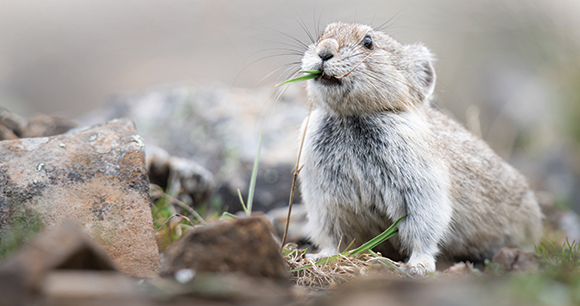by Dr. Jessica Castillo Vardaro, Department of Biological Sciences, San Jose State University
American pikas (Ochotona princeps) are small, adorable mammals found throughout the mountains of western North America. They have gained public attention and are a species of conservation concern due to a rapidly changing climate and their sensitivity to high temperatures. A proposal to list the species under the Endangered Species Act was denied by the US Fish and Wildlife Service in 2010 despite the agency’s acknowledgment that many of the pika populations in the Great Basin region are likely at risk of local extinction. These vulnerable sites are hotter, drier, lower in elevation, and more geographically isolated than those found in the Sierra Nevada, Cascade, and Rocky Mountains.

This research, funded in part by a Christine Stevens Wildlife Award from the Animal Welfare Institute, uses noninvasively collected fecal samples and modern genetic techniques to investigate pika diet, intestinal parasites, and population genetic metrics to better understand population vulnerability. This is not only the first project to integrate these three crucial aspects of pika biology, it is also the only study specifically addressing these questions within the Great Basin.
The study targeted multiple sites in the Great Basin region of northwestern Nevada, as well as the southern Sierra Nevada mountains in California, to look at the potential threats to these populations. Historically, such research would have required labor-intensive pika trapping, which has an inherent risk of mortality to the animals. Instead, by collecting fecal pellets, we were able to sample a larger number of individuals from a much broader geographic area without disturbing or harming these sensitive animals.
In collaboration with the Nevada Department of Wildlife, three graduate students (Michael Hernandez, Emily Hadjes, and Jazmine Camacho Servin) and I collected over 100 pika fecal samples. A team of undergraduate student researchers extracted DNA from the samples, thereby collecting DNA from the pikas, as well as from the plants they ate and any parasites living in their intestinal tracts. Population genetic analyses using microsatellites revealed varying levels of connectivity among populations in northwestern Nevada, consistent with the low dispersal ability of American pikas and the patchy distribution of their rocky habitat. This vital information contributes to our understanding of why some populations appear more stable than others.
Dietary analysis of fecal samples, using a DNA metabarcoding approach, revealed a high level of diversity of plant species, consistent with the generalist foraging nature of American pikas (they are not picky eaters). Individual fecal samples contained, on average, five different plant species. Common plants eaten by pikas include antelope bitterbrush and gooseberry. This important research using noninvasive sampling tools will greatly increase our understanding of pika persistence in a changing ecosystem.